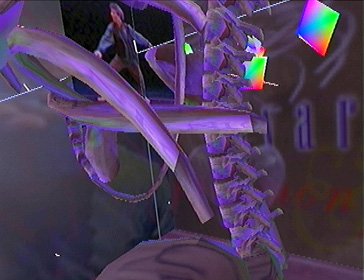 |

 "VR seemed to offer quite similar sensations ... the extreme pleasure associated with open-ended textuality, the loss of bodily boundaries and a diffused or fragmentary subjectivity" -- Diane Gromala  |
Re-embodiment Dancing with the Virtual Dervish: Virtual Bodies ___by Diane Gromala More than merely informing my work, disease, pain, technology, and their effect on subjectivity have been generative, if not coercive, forces. In the realm of subjective experience, certain disease processes provoke an inescapable confrontation with the unknowable, the unspeakable, the unsharable. It is precisely this arena of human experience that concerns me a long artistic tradition and perhaps a quixotic compulsion to share and perform the unrepresentable through critically-informed artistic practices. Through Dancing with the Virtual Dervish: Virtual Bodies, (1) I explored the consciousness-altering bodily responses provoked by immersive VR technology and its potential to disrupt subjectivity. Discourses surrounding VR often link the most characteristic affect of VR on our proprioceptive sense -- of "where we are in our bodies" -- to a desire to escape the constaints of the body, often termed "disembodiment." Contesting this traditionally masculinist notion as the primary desire of the user, I instead related the unfamiliar sensation and cognitive disruption to my strategies for dealing with chronic pain, that is, for a reconfigured and enhanced experience of my body, a "re-embodiment." 
Rather than employing the "distraction" methods of meditation favored by Western medical practices as strategies for living with chronic pain, I instead draw on certain Eastern traditions, where meditative states can lead to a sense of inward expansiveness and a newly informed connectedness to our bodies. VR seemed to offer quite similar sensations, which I related to Helene Cixous' and Julia Kristeva's notions of the jouissance -- the extreme pleasure associated with open-ended textuality, the loss of bodily boundaries and a diffused or fragmentary subjectivity. (2) This piece offers users an opportunity to explore the potentially disruptive embodied subjectivity through immersive interactions with data and images of parts of my body. Derived from artistically manipulated "objective" MRI data of my body, users can explore this VR environment, which exists in a reactive state of decay and reformation. Literal pictorial and sonic representation of enormous body parts reveal paradoxically larger, surreal worlds as the user travels or "flies" within them. Poetic text wrapped around these organic structures defines them, but simultaneously confounds what constitutes inside with outside, the distance of the bodily responses to representation, indistinct separations between body and machine, (3) and the primacy of text over images. |
||